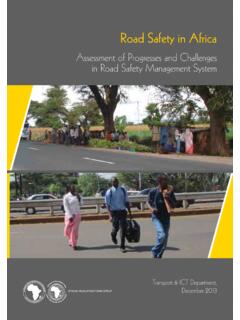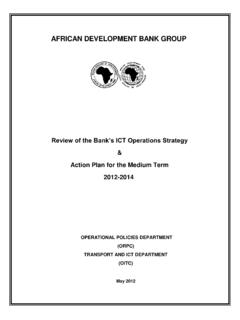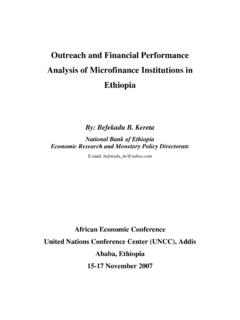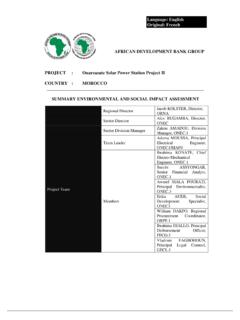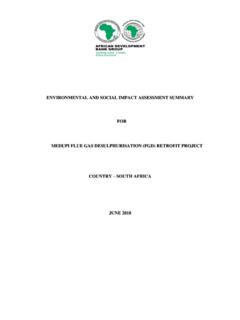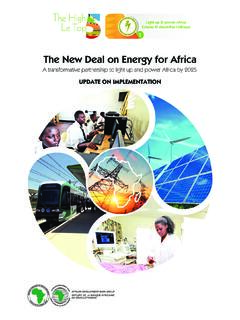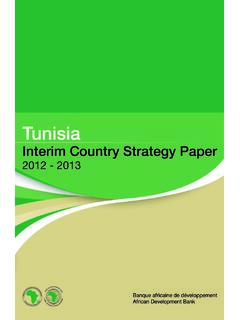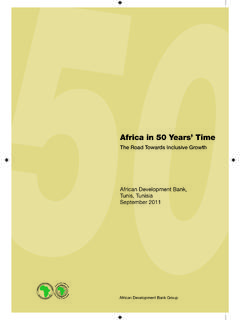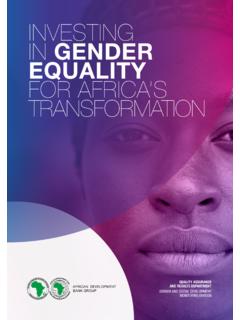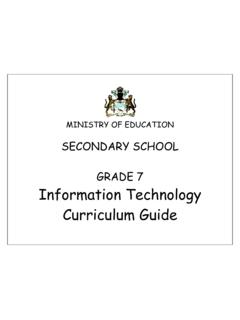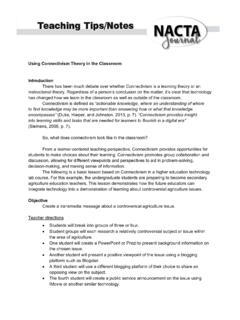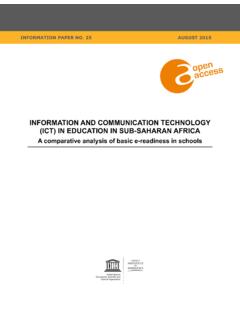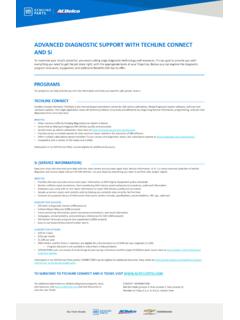Transcription of CHAPTER 12: Information and Communications Technology
1 CHAPTER 12: Information and Communications Technology THE SETTING domestic or cross-border terrestrial links and international undersea highways, is recognized Communications in the worldwide as the main catalyst of ICT. development and as enabler of development Southern Africa Region policies that bene t both corporate and private For Sub-Saharan Africa as a whole, there has users. For this reason, broadband network been remarkable growth in Information and projects are especially relevant for the region Communications Technology (ICT) services and form part of the NEPAD agenda in the ICT. in the past decade. Most of the expansion in sector within the Southern Africa region. ICT services has been in voice services with At the same time, there has been a mobile networks.
2 Fixed line telephone services major push by African leaders to accelerate and access to the Internet have grown more development of the Communications industry. slowly. At the October 2007 Heads of State Summit Southern Africa relies heavily on satellites to meeting in Kigali, it was agreed that the World manage its long distance telecommunications. Summit on the Information Society (WSIS). Nowadays, a modern optical ber digital targets would be framed around ve basic telecommunication network, consisting of goals for Sub-Saharan Africa (Box ). Box : Goals of the connect Africa Summit (Kigali, 2007). Goal 1: Interconnect all African capitals and major cities with ICT broadband infrastructure and strengthen connectivity to the rest of the world by 2012.
3 Goal 2: connect African villages to broadband ICT services by 2015 and implement shared access initiatives such as community telecenters and village phones. Goal 3: Adopt key regulatory measures that promote affordable, widespread access to a full range of broadband ICT services, including Technology and service neutral licensing/authorization practices, allocating spectrum for multiple, competitive broadband wireless service providers, creating national Internet Exchange Points (IXPs), and implementing competition in the provision of international Internet connectivity. Goal 4: Support the development of a critical mass of ICT skills required by the knowledge economy, notably through the establishment of a network of ICT Centers of Excellence in each sub-region of Africa and ICT capacity- building and training centers in each country, with the aim of achieving a broad network of inter-linked physical and virtual centers, while ensuring coordination between academia and industry by 2015.
4 Goal 5: Adopt a national e-strategy, including a cyber-security framework, and deploy at least one agship e-Government service as well as e-Eucation, e-Commerce, and e-Health services using accessible technologies in each country in Africa by 2012, with the aim of making multiple e-Government and other e-services widely available by 2015. POLICY FRAMEWORK Communications , and Meteorology of 1996. AND INSTITUTIONAL that called for member states to create a ARRANGEMENTS harmonized regional telecommunications policy, the Government adopted a sector reform policy that called for universal access Policy Framework for the to affordable telecommunications and postal Telecommunications Sector services. It also emphasized the need for improvements in service availability and In response to the Southern Africa Development quality, and the development of new services Community (SADC) Protocol on Transport, through de-monopolization and privatization.
5 Information and Communications Technology Zimbabwe Report 1. Implementation of these policy objectives The privatization of Tel*One and Net*One began with the Postal and Telecommunication was approved by the Government in Act of 2000. The bill effectively ended the November 2001. The planned equity structure monopoly of the Post and Telecommunications was to leave the Government with 70 percent Corporation, which was split into three shareholding with the remaining 30 percent commercial units, the xed telephone provider offered to a strategic partner. International Tel*One, the mobile cellular company tenders were called for in January 2002, (Net*One), and the public postal operator inviting potential partners to express interest. (Zimpost).
6 This bill also provided for the From 12 applicants, four companies were pre- creation of the Postal and Communications quali ed. Negotiations with these bidders Regulatory Authority of Zimbabwe (POTRAZ), were, however, unsuccessful and all eventually which was created to ensure a level playing eld withdrew their offers. Subsequent attempts by in the posts and telecommunications sector. the Government to attract other investors were Its mandate is to license operators and ensure also unsuccessful, with potential investors that the services provided are of an acceptable deciding, at the time, that Zimbabwe was not standard. Its operating budget is funded through conducive to such investments. revenues from licensing and a levy on the gross During the latter part of 2008, POTRAZ.
7 Turnover of operators in the ICT sector. Those took a major step towards unifying existing granted licenses are required to contribute licenses to allow licensed operators to offer to a Universal Service Fund (USF) designed all types of services that can be supported to support the expansion of Communications by their existing networks. services to under-funded areas. Institutional Arrangements Tel*One, Net*One, Powertel/ZESA, and the for the Industry Zimbabwe Broadcasting Corporation. Before the creation of the Ministry of Information Currently, the Government controls the ICT and Communications Technology (MICT). regulatory agencies (POTRAZ, BAZ, and in April 2004, responsibility for Information MIC) and a number of the dominant service and Technology policy and activities in providers in the market.
8 These include Zimbabwe was fragmented among various 2 Zimbabwe Report Information and Communications Technology ministries, including the Ministry of Science Separation of power and authority will help and Technology , the Ministry of Media, the decrease instances of regulatory confusion Ministry of Transport and Communications , in cases where one institution oversteps and the Ministry of Finance. The creation of its legal mandate. CHAPTER 4 provides a the new ministry has resolved a number of detailed description of the existing regulatory the issues related to divided responsibilities, framework for the sector and identi es a but some responsibilities for ICT policy number of emerging issues that need to be and programs remain with the Ministry of addressed in the near future Transport and Communications and the Broadcasting Fund.
9 BAZ is mandated Ministry of Media, Information , and Publicity, to establish and manage the Broadcasting each of which oversees the regulators for the Fund (BF) whose main purpose is to provide ICT sector. disadvantaged communities' with access to Legislative framework for regulation television and radio services and provide funds of ICT. There are four separate pieces for the development of Zimbabwe's lm and of legislation that have a bearing on the music industries. The Fund is not required to regulatory environment for the Information make its accounts available to the public, so and Communications Technology Industry there is no clear record of the extent to which in Zimbabwe. These are the Postal and Fund resources have been used in the manner Telecommunications Act of 2000, the intended.
10 Broadcasting Services Act of 2001, the Universal Service Fund. In 2001, the Access to Information and Protection of Government announced a policy on Privacy Act of 2002, and the Interception universal services that was modeled along of Communications Act of 2007. At the the universal service guidelines of SADC. present time, regulation of the ICT sector is and created the Universal Service Fund (USF). divided between the Broadcasting Authority Operators contribute 5 percent of their gross of Zimbabwe (BAZ), POTRAZ, and the revenue to fund projects in underdeveloped Media and Information Commission (MIC). areas. According to the policy, the regulator, POTRAZ is accountable to the Minister of POTRAZ, should have achieved the following Transport and Communications , while BAZ community access targets: (i) increasing and the MIC report to the Minister of Media, teledensity in urban areas to 10 percent in 2006.
